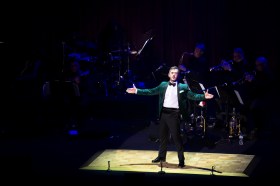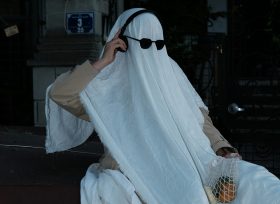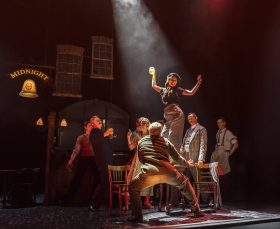It has become trite to say that there is a fine line between genius and insanity, and yet the saying seems to have lost none of its veracity. If the numerous autobiographies, biographies and psychiatric diagnoses of some of the most famous people throughout history are to be believed, then mental illness is indeed much more prevalent among great artists than the general population. Among these we can count John Keats, Ludwig Van Beethoven, Leo Tolstoy, Ernest Hemingway, Virginia Woolf and Sylvia Plath, to name a few; but even if we have yet to discover the Van Gogh of our time, contemporary examples are out there too.
Musical theatre star Meera Popkin is one of them; she went from West End to waitressing at Wendy’s after being diagnosed with a mild case of schizophrenia in 1997. “I could not get hired,” she recounted of her struggle with the disease. “I lost my house, my car, my dog and my boyfriend…My world was shattered. I didn’t know what to think of myself.”
So what did Popkin do to bring about the return to Broadway that she has since effected? “I’ve been going to The Awakenings support group,” she said. “I’m a martial artist, and I often have time for dance class. I’m active in my Actors Equity Union; I have a voice lesson once a week, and I practice all the time.”
If that sounds like a lot of art therapy, it merely underscores the role that art has played in creating, maintaining and restoring the emotional health of everyone from artists to homeless people, troubled youth and sufferers of such conditions as Alzheimer’s disease. In the US, the American Art Therapy Association acts as the hub of all things pertaining to regenerative artistic activity, but there are many other projects, societies and organizations dedicated to the treatment of mental illness through art.
The Awakenings Project is an Illinois-based non-profit arts organization that assists persons with mental illness to develop artistic abilities through all forms of art, including art exhibitions, a drama program and a literary publication entitled The Awakenings Review. The Society for the Arts in Healthcare, which is located in Washington, D.C., promotes the integration of the arts in healthcare through conferences, meetings and symposiums, and the Irwin Foundation‘s Celebration Recovery program toasts the convalescence of individuals with mental illnesses such as depression, schizophrenia and bipolar disorder with music and dancing. And Michael Purington and the Messengers make music CDs to help alcoholics learn to live sober.
The healing properties of art are anecdotally well-supported by experiments such as those run by the Museum of Modern Art and the Museum of Fine Art, both of which run guided tours for Alzheimer’s disease patients. Observers say the art lifts patients’ moods and elicits articulate and animated responses from even those who had no previous interest in or aptitude for art. And now, studies are showing that this could be due to genetic similarities that artists share with the mentally ill.
Dr Daniel Nettle, a psychologist in brain and behavior at the UK’s University of Newcastle, has said that artists and schizophrenics share a key cognitive trait called “unusual cognition” that predisposes to creativity.
“Schizophrenia is so disruptive that it isn’t common in very successful people,” said Nettle. “But if you have some of the traits, such as this unusual way of viewing the world, without the debilitating social withdrawal, and you find a way of channeling the creativity that gives you, it can be very attractive.”
Hence the perception that art and madness go hand-in-hand, most clearly illustrated by artists such as Van Gogh, whose eventual psychosis was preceded by a period of manic productivity in which he created over two hundred paintings in less than two years. But if creativity can collapse into madness, so too madness has been known to induce creativity: abstract expressionist painter Willem de Kooning’s descent into Alzheimer’s, for example, changed his style in a way that some saw as setting the artistic trend of clean, surface-oriented painting for the 1990s and the 21st century, and influencing contemporary painters such as Brice Marden.
In fact, psychiatrists have speculated that schizophrenia was responsible for the creation of jazz. Professor Dr Sean Spence of the department of psychiatry at the University of Sheffield said that Charles “Buddy” Bolden, a New Orleans cornetist, may have been forced to “make things up as he went along” because his disease impaired his motor functions and prevented him from reading music.
“It may be that he had to improvise because he could not play tunes in a useful way,” Dr Spence said. “If we had not had this improvised music then it (jazz) would just have continued as ragtime.”
But while Bolden’s illness effectively destroyed his talent, trumpeter and fellow jazzman and schizophrenic Tom Harrell has soldiered on for over 25 years despite the mood swings, hallucinations and thought disorders brought on by the disease. Neuroleptic medication helps, but so does his music, reducing the side effects that the medication brings on and producing a more intangible feeling of well-being.
“Improvising is a very visual experience for me,” Harrell described of his art. “The melodies have contours, and the harmonies have colors, and the rhythms have visual qualities because they happen in time, which gives them emotional implications.”
One artist who uses her art not only as a creative outlet, but also as a way of de-stigmatizing mental illness, is painter and poet Mara McWilliams. In recovery from a diagnosis of bipolar disorder, panic disorder and anorexia, McWilliams says that her website helps other bipolar individuals and the general public to understand that art helps to foster health and productivity in those living with mental illnesses.
Through studies such as Dr Nettle’s, which measure the degree of cognitive similarity between artists and schizophrenics, we are slowly forging an understanding of the links between art and mental health. For many of us, art requires no specific justification to exist; for those to whom it might, we can always safely point to the positive effects of art therapy in the prevention and alleviation of suffering.




